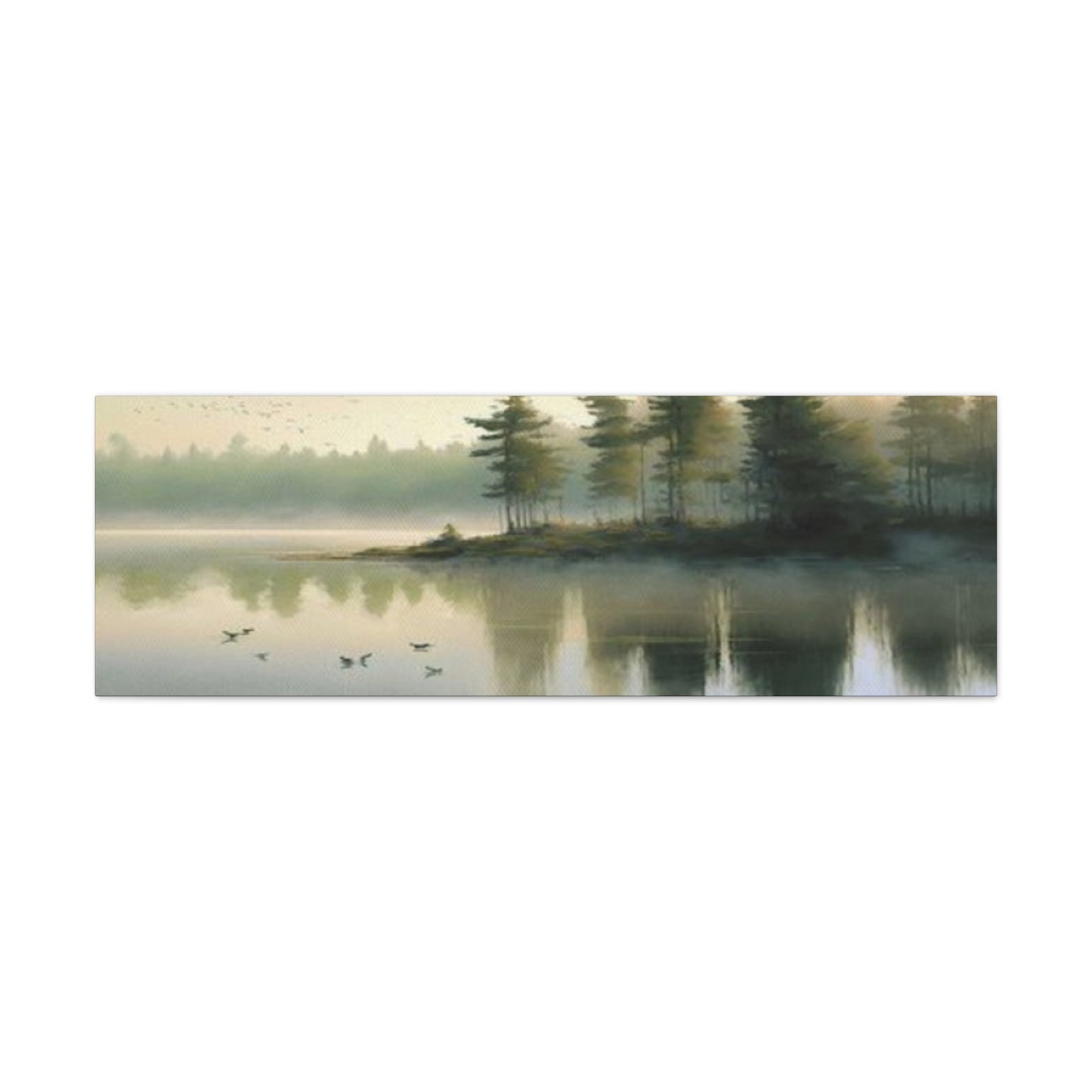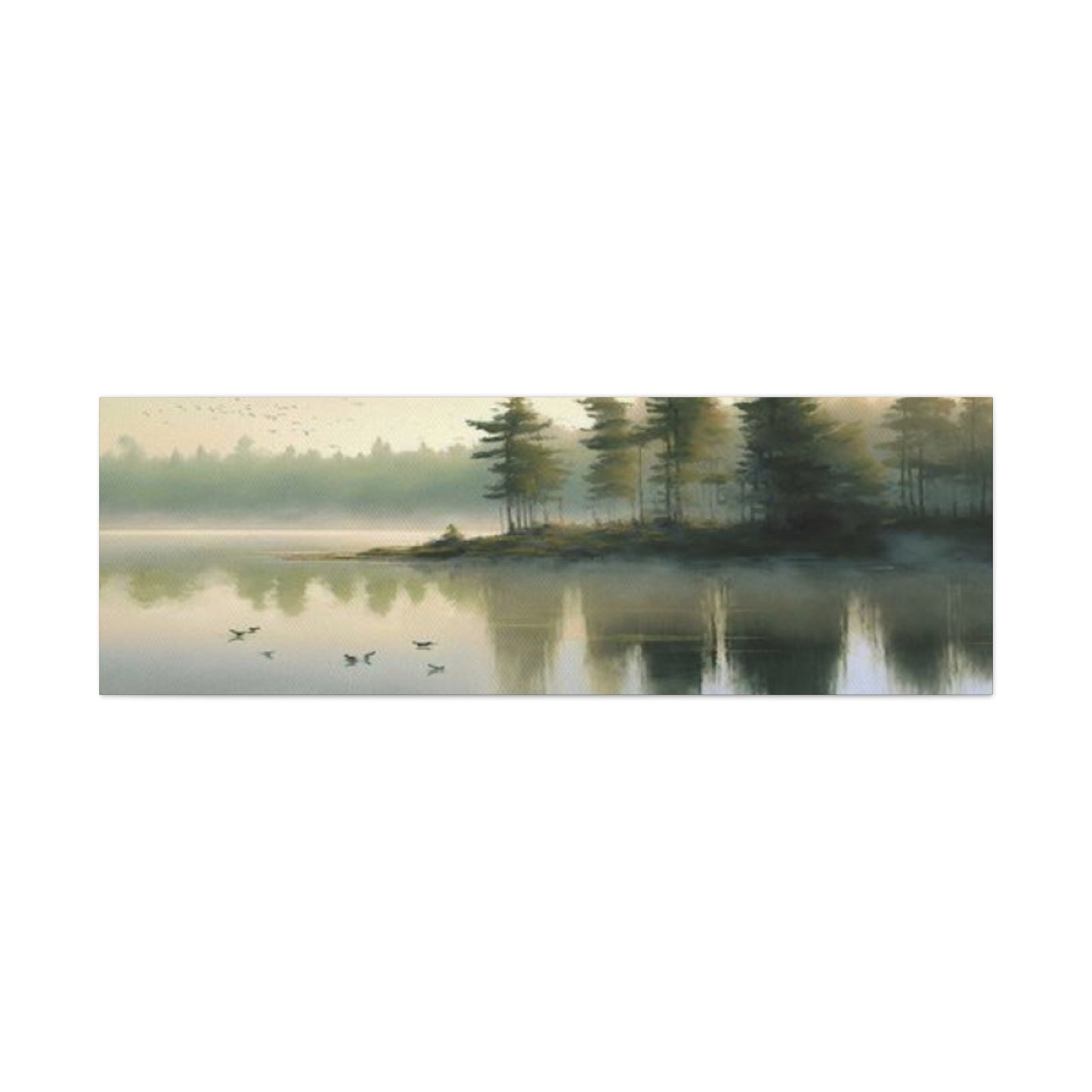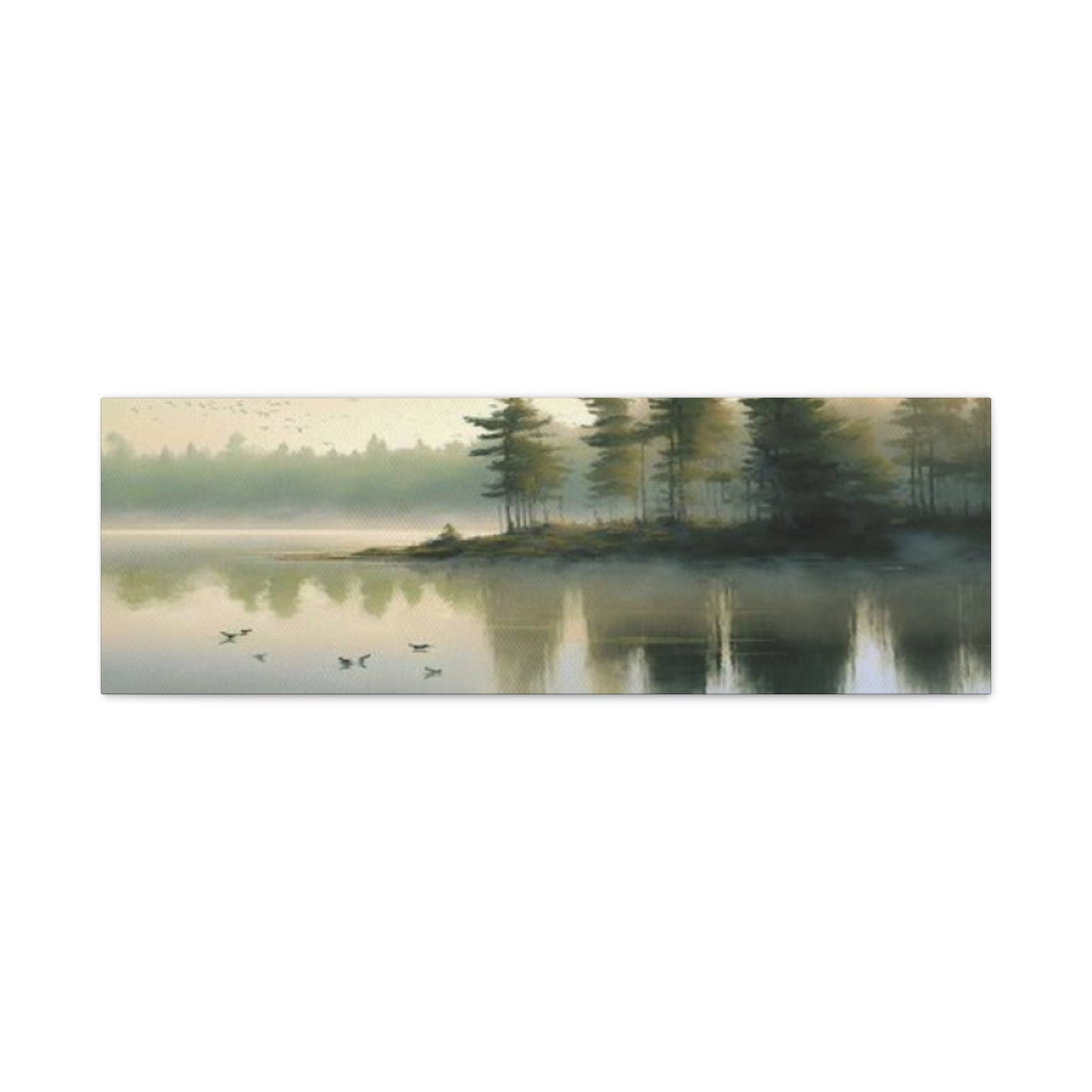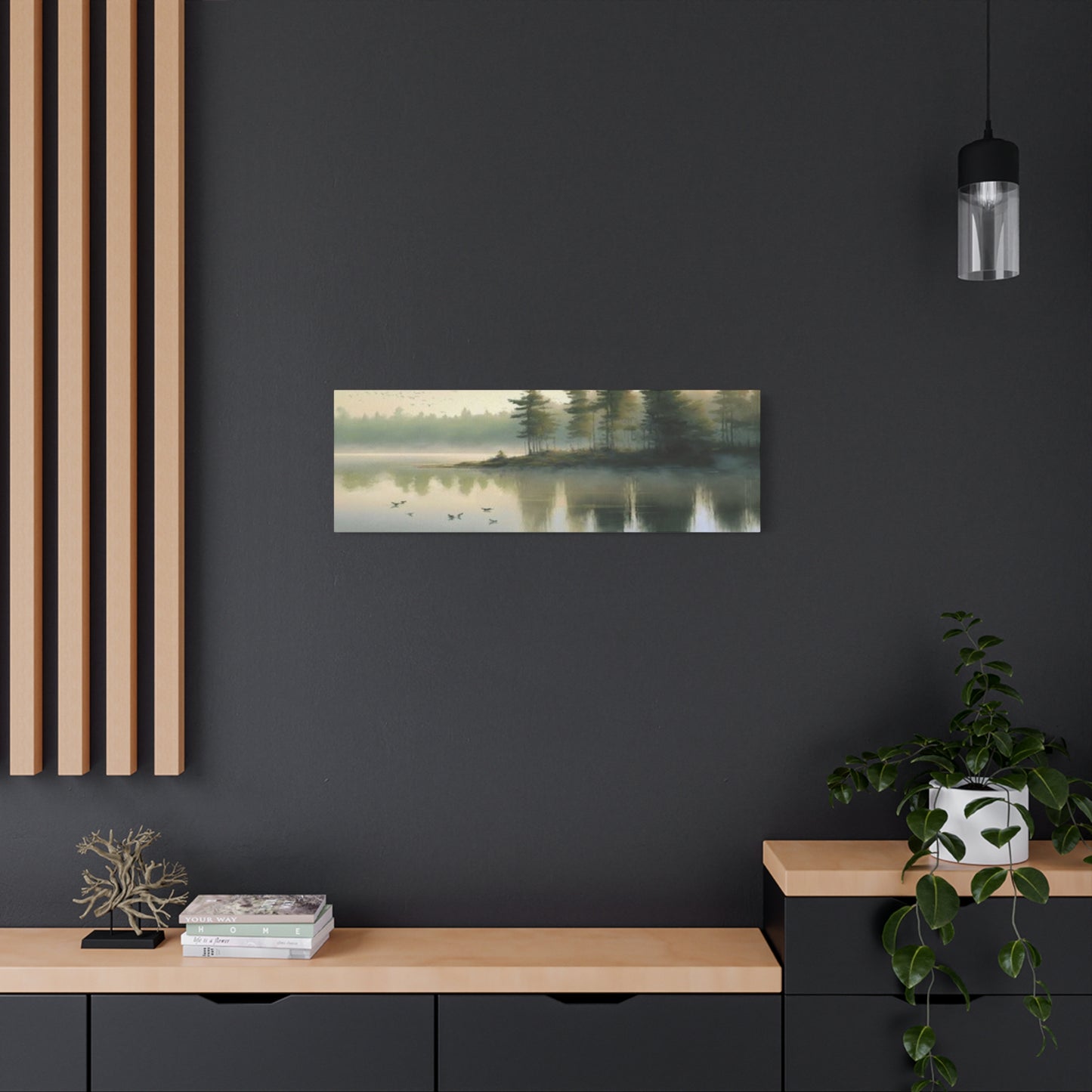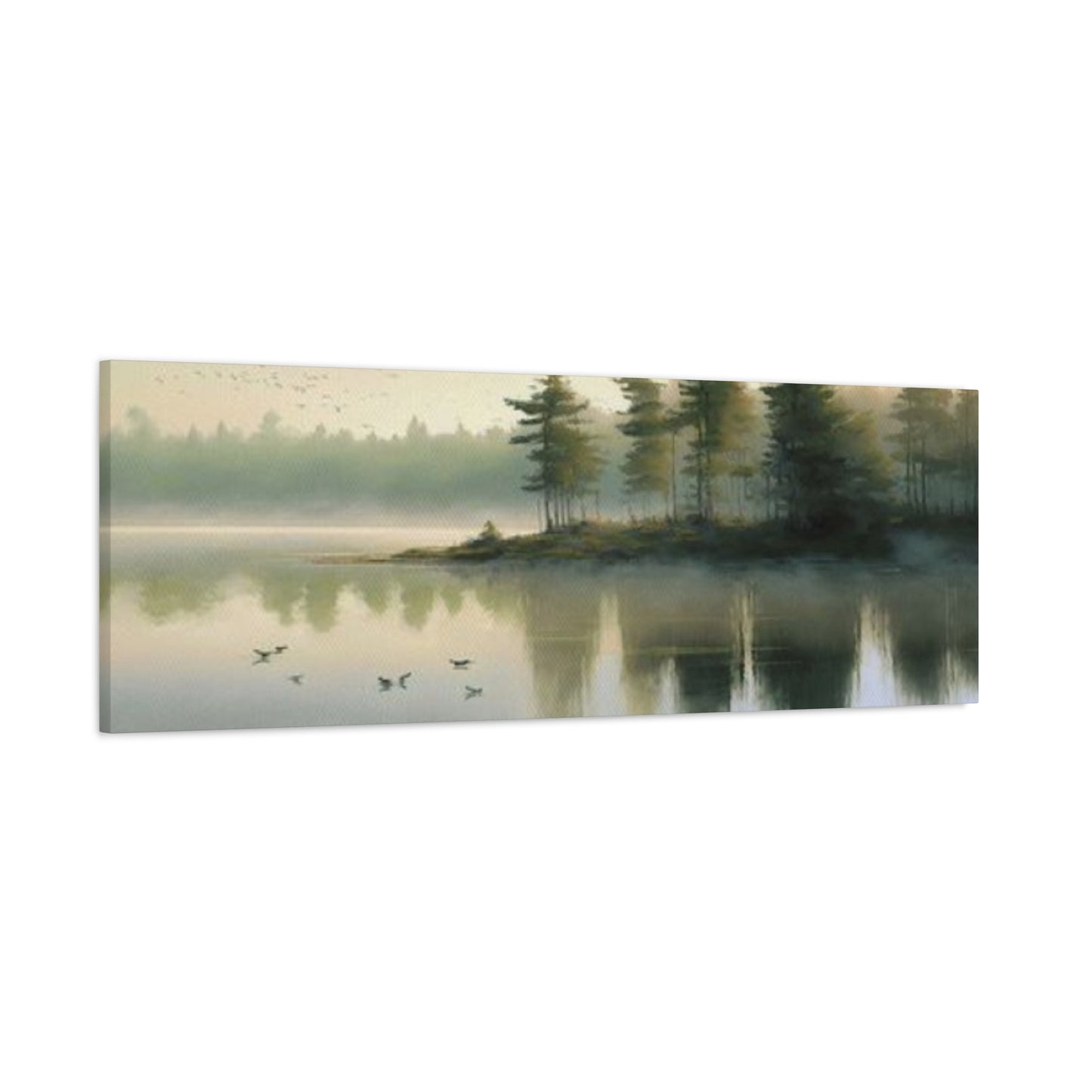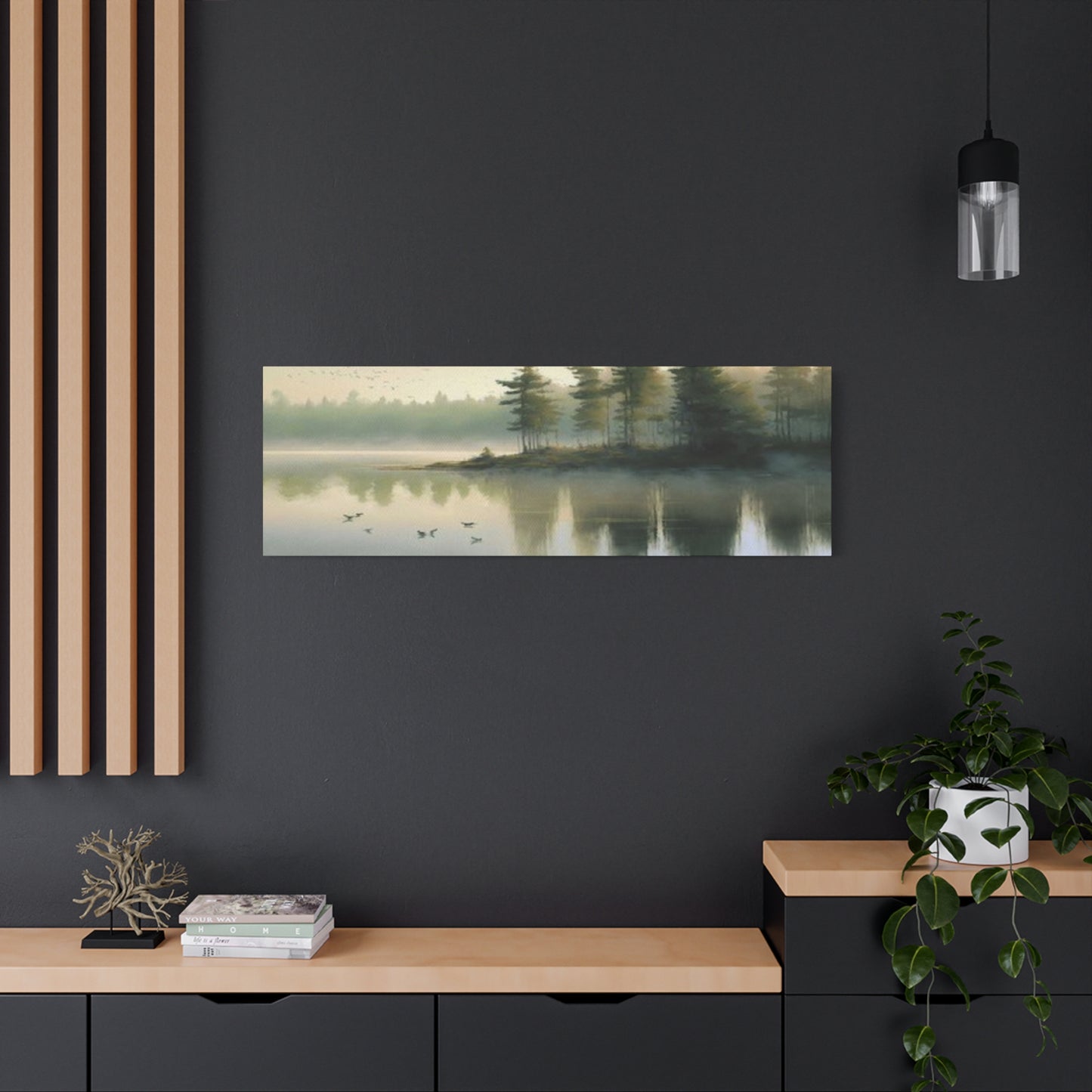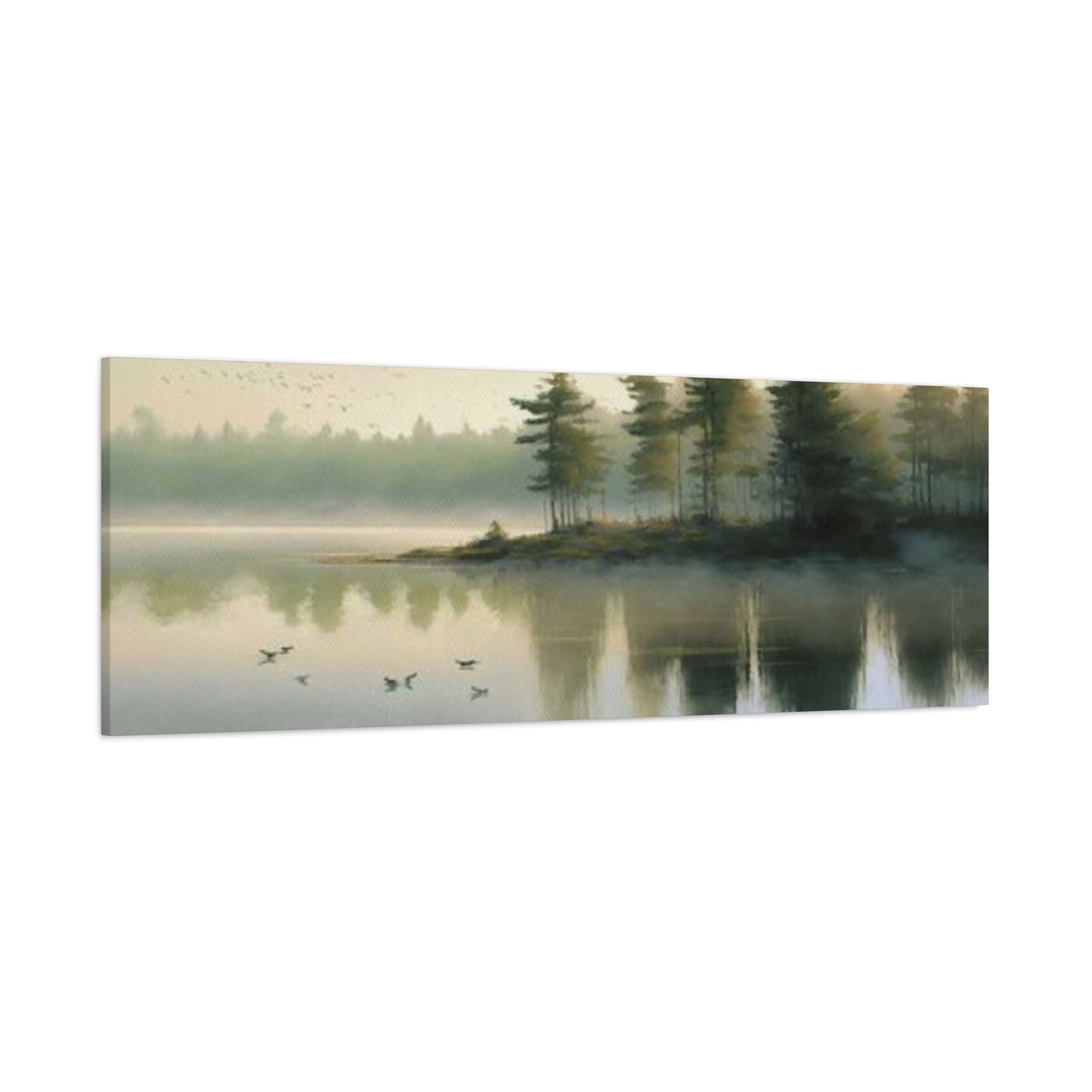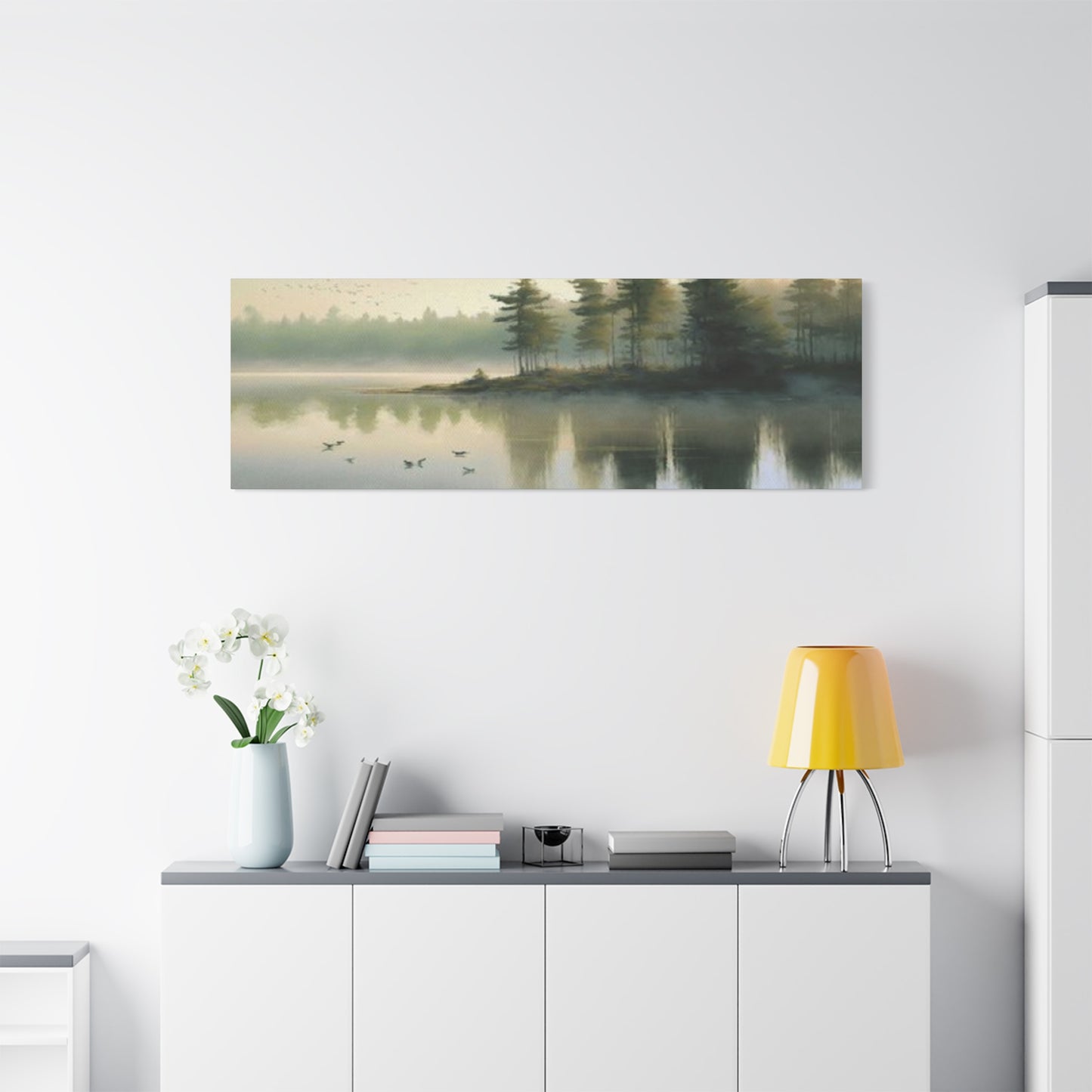Healing Power of Nature: How Wild Lake Panoramas Wall Art Can Reduce Stress
Wild lake panorama canvas wall art represents one of the most captivating ways to introduce natural beauty into interior spaces. These expansive artworks capture the sweeping grandeur of untouched lakeside landscapes, offering viewers an immersive visual experience that transcends traditional wall decoration. The panoramic format naturally lends itself to lake scenes, as it mirrors the way our eyes naturally scan across vast water bodies and distant horizons. When you incorporate these pieces into your home or office, you're not merely hanging artwork; you're opening a window to pristine wilderness that can be appreciated daily.
The appeal of wild lake panorama canvas extends beyond mere aesthetics. These artworks serve as focal points that can anchor entire room designs, drawing the eye and creating a sense of depth even in compact spaces. The horizontal orientation of panoramic prints makes them particularly suitable for placement above sofas, beds, or console tables, where they can span significant wall space without overwhelming the room. The natural color palettes found in lake scenes, ranging from deep blues and greens to softer pastels during sunrise or sunset, complement virtually any interior design scheme.
Canvas as a medium offers distinct advantages for displaying lake panoramas. Unlike paper prints or posters, canvas provides texture and depth that enhances the organic nature of the subject matter. The fabric surface diffuses light in ways that create subtle variations in appearance throughout the day as natural lighting changes. This living quality makes canvas particularly appropriate for nature scenes, as the artwork itself seems to breathe and shift with your environment. Additionally, gallery-wrapped canvas creates a finished, professional appearance without requiring costly framing, making these pieces accessible while maintaining their artistic integrity.
When selecting wild lake panorama canvas wall art, consider how the specific scene resonates with your personal connection to nature. Some panoramas capture the raw power of mountain lakes surrounded by peaks, while others showcase the serene stillness of forest-enclosed waters. The emotional impact of these scenes varies significantly based on composition, color temperature, and atmospheric conditions depicted. A misty morning lake scene evokes tranquility and contemplation, while a sunset-illuminated panorama brings warmth and vitality. Your choice should reflect not only your aesthetic preferences but also the mood you wish to establish in your space.
The scale of panoramic lake artwork demands thoughtful placement. These pieces work best where they can be viewed from appropriate distances, allowing the full breadth of the scene to be appreciated. In living rooms, positioning panoramic canvas above seating areas creates a natural sight line for relaxation. In bedrooms, placing these artworks opposite the bed provides a peaceful view to wake up to and contemplate before sleep. Office spaces benefit from the stress-reducing qualities of natural imagery, with lake panoramas offering mental escape during intensive work periods.
Scenic Lake Wall Décor Prints
Scenic lake wall décor prints encompass a broader category of lakeside imagery designed specifically for interior decoration purposes. Unlike purely artistic interpretations, these prints balance aesthetic beauty with decorative functionality, ensuring they enhance living spaces while celebrating natural landscapes. The term encompasses various printing techniques, sizes, and styles, all united by their focus on lake scenery that transforms ordinary walls into captivating visual experiences. These prints serve dual purposes: they satisfy our innate attraction to water and natural environments while providing sophisticated visual interest to residential and commercial interiors.
The diversity within scenic lake wall décor prints allows for personalized expression in home design. You might choose dramatic alpine lakes with craggy peaks reflected in crystal-clear waters, peaceful pond-like settings surrounded by autumn foliage, or expansive reservoir views that stretch to distant horizons. Each style communicates different aesthetic sensibilities and emotional tones. Mountain lake scenes often project strength and adventure, appealing to those who value outdoor recreation and wilderness exploration. Forest lake prints typically convey serenity and retreat, perfect for creating sanctuary-like atmospheres in bedrooms or meditation spaces. Open-water lake scenes suggest freedom and possibility, making them excellent choices for offices or creative studios.
Print quality varies substantially across the market, making informed selection crucial for satisfaction. Premium scenic lake prints utilize high-resolution source images captured by professional landscape photographers who understand optimal lighting, composition, and timing. The printing process itself should employ archival-quality materials that resist fading, moisture damage, and deterioration. Giclée printing, which uses fine art inkjet technology, produces exceptional detail and color accuracy that distinguishes superior prints from mass-market alternatives. When evaluating potential purchases, examine how well the print captures fine details like ripples on water surfaces, reflections of surrounding landscapes, and textures in shoreline vegetation. These elements separate compelling artwork from merely adequate decoration.
Framing choices significantly impact how scenic lake wall décor prints integrate with existing interiors. Traditional wood frames in natural finishes complement the organic subject matter while adding warmth and structure. Modern metal frames create contemporary presentations that emphasize the imagery itself with minimal distraction. Floating frames, which suspend prints between glass panels, add dimensional interest and protect the artwork while creating gallery-quality presentations. Some prints work beautifully without frames when mounted on rigid backing or printed directly onto metal or acrylic substrates. Your framing decision should consider both the specific print and the surrounding décor to create cohesive visual harmony.
Color coordination between scenic lake prints and room palettes requires attention to undertones and intensity. Lake scenes typically feature blues, greens, and earth tones that pair naturally with neutral wall colors. However, the specific shades within these color families vary considerably. Cool-toned lake prints with steely blues and gray-greens complement modern interiors with similar cool palettes, while warm-toned scenes featuring golden hour lighting work beautifully with cream, beige, and warm gray walls. Consider pulling accent colors from the print to incorporate into throw pillows, blankets, or decorative objects, creating intentional connections between artwork and furnishings.
Panoramic Nature Canvas Wall Art
Panoramic nature canvas wall art extends beyond lake-specific imagery to encompass the full breadth of natural landscapes presented in wide-format compositions. This category includes forests, mountains, deserts, coastal scenes, and meadows alongside lake views, all united by their horizontal emphasis and immersive perspective. The panoramic format inherently suits nature photography because it mirrors how we naturally experience outdoor environments, with our eyes scanning across vistas rather than focusing on vertical compositions. When you incorporate panoramic nature canvas into your space, you're essentially bringing the horizon indoors, creating visual expansion that makes rooms feel larger and more connected to the natural world.
The psychological impact of panoramic nature artwork differs from standard rectangular compositions. Wide-format images engage peripheral vision, creating more immersive experiences that can temporarily transport viewers beyond their immediate surroundings. This quality makes panoramic nature canvas particularly valuable in urban environments where daily exposure to natural landscapes may be limited. Office workers spending hours in artificial environments benefit significantly from panoramic nature views that provide mental escape and reduce cognitive fatigue. Even brief glances at these expansive natural scenes can refresh attention spans and improve productivity.
Compositional principles specific to panoramic nature photography influence the effectiveness of resulting canvas art. Successful panoramic compositions typically feature strong horizontal elements like tree lines, shorelines, or mountain ridges that guide the eye across the image. Leading lines that draw viewers into the scene create depth despite the horizontal emphasis. The rule of thirds remains relevant in panoramic formats, but photographers adapt it to the extended width, often placing primary focal points at intersections further from center than in standard compositions. When selecting panoramic nature canvas, consider how these compositional elements create balanced, engaging imagery rather than simply stretched standard photos.
Lighting conditions captured in panoramic nature canvas dramatically affect mood and interior impact. Golden hour photography, shot during the first and last hours of sunlight, bathes landscapes in warm, directional light that creates long shadows and rich colors. These pieces bring warmth and vitality to spaces, making them excellent choices for social areas like living rooms and dining rooms. Blue hour images captured during twilight feature cooler tones and ethereal qualities perfect for bedrooms or contemplative spaces. Midday scenes with bright, even lighting work well in kitchens and bathrooms where energy and clarity are priorities. Storm photography with dramatic clouds and moody atmospheres creates striking focal points in studies or home offices.
Material considerations for panoramic nature canvas include canvas weight, stretcher bar depth, and edge treatment. Heavier canvas weights provide superior durability and a more substantial presence on the wall. Deeper stretcher bars, typically 1.5 to 2 inches, create shadow gaps between canvas and wall that add dimensional interest and contemporary styling. Edge treatments vary between gallery wrapping, where the image continues around sides, and mirrored or solid color edges. Gallery wrapping works beautifully when the image composition allows, eliminating hard stops at frame edges and creating seamless visual flow. For images with important compositional elements near borders, mirrored edges maintain image integrity while providing finished appearance.
Wild Lake View Canvas Wall Décor
Wild lake view canvas wall décor specifically emphasizes the untamed, pristine quality of natural lake environments removed from human development. These pieces celebrate lakes in their most authentic state, free from visible structures, boats, or other indicators of civilization. The term wild suggests remoteness, purity, and the kind of natural beauty that requires effort to access in person. By bringing wild lake views into interior spaces, you create connections to wilderness that may be geographically distant but emotionally resonant. These artworks appeal particularly to those who value environmental preservation, outdoor adventure, and escape from increasingly urbanized modern life.
The distinction between wild lake views and more generic lake imagery lies in compositional choices and environmental context. Wild lake view canvas typically features pristine waters surrounded by undisturbed shorelines, native vegetation, and natural geological features. The absence of docks, buildings, and human figures reinforces the wilderness quality. Photographers capturing these scenes often work in protected areas, national parks, or remote backcountry locations where development restrictions preserve natural character. The resulting images communicate not just beauty but also the value of conservation and the importance of maintaining wild spaces in an increasingly developed world.
Seasonal variations in wild lake view canvas offer diverse aesthetic possibilities. Winter scenes showcase frozen surfaces with snow-covered surroundings, creating monochromatic compositions with subtle color variations in whites, grays, and blues. These pieces bring cooling visual effects to spaces while celebrating the stark beauty of cold-season landscapes. Spring imagery captures lakes emerging from ice, with melting snow feeding streams and early vegetation beginning to green shorelines. Summer wild lake views present lush surroundings, clear skies, and vibrant colors that energize spaces with warmth and vitality. Autumn lake scenes feature reflected foliage in brilliant reds, oranges, and yellows, creating rich, warm palettes perfect for cozy interior environments.
Wildlife presence in wild lake view canvas adds narrative interest and reinforces natural authenticity. Images featuring birds like loons, herons, or eagles establish ecosystem context and appeal to wildlife enthusiasts. Distant deer at shorelines or bears fishing in streams tell stories about interconnected natural communities. Even without visible animals, signs of wildlife like tracks in shoreline mud or nests in overhanging branches communicate the vibrant life these ecosystems support. When selecting wild lake view canvas, consider whether you prefer pristine landscape focus or appreciate wildlife elements that add biological dimension to the artistic composition.
Atmospheric conditions dramatically influence the character of wild lake view canvas. Clear-sky conditions showcase vivid colors and sharp details, celebrating visual clarity and the transparency of pristine waters. Cloud presence adds drama and variety, from wispy cirrus formations suggesting fair weather to dramatic cumulonimbus buildups hinting at approaching storms. Fog and mist create ethereal, dreamlike qualities that emphasize mystery and the ephemeral nature of landscape experiences. Rain effects and storm conditions, while less common in decorative art, appeal to those who appreciate nature's power alongside its beauty. Your selection should reflect both aesthetic preferences and the emotional atmosphere you wish to establish in your space.
Serene Lake Landscape Canvas Prints
Serene lake landscape canvas prints emphasize tranquility, stillness, and peaceful beauty found in calm water environments. The term serene specifically indicates compositions that prioritize these contemplative qualities over dramatic or action-oriented elements. These prints typically feature glassy water surfaces that reflect surrounding landscapes like mirrors, soft color palettes that avoid jarring contrasts, and compositions that promote visual rest rather than energetic eye movement. When you incorporate serene lake landscape canvas into your home, you're making a deliberate choice to cultivate peaceful atmospheres that support relaxation, meditation, and emotional calm.
The compositional elements that create serenity in lake landscape canvas involve both what is included and what is excluded. Successful serene compositions typically feature horizontal lines that suggest stability and rest, with horizon placements that create balanced divisions between sky and water. Symmetrical or near-symmetrical arrangements, particularly those featuring perfect reflections, promote visual harmony that reads as peaceful. Minimal wave action or ripples suggest stillness and lack of disturbance. Soft, diffused lighting rather than harsh directional light creates even tonalities without dramatic shadows. The absence of obvious human presence or activity allows viewers to project themselves into the scene without encountering visual evidence of others.
Color psychology plays crucial roles in establishing serene qualities in lake landscape canvas prints. Cool color palettes dominated by blues, soft greens, and purples naturally promote calm and reduce physiological arousal. These colors lower heart rate and blood pressure, creating measurable relaxation responses. Muted saturation levels feel more peaceful than highly saturated colors, which command attention and create visual excitement. Pastel tones with high lightness values open spaces visually while maintaining softness. Monochromatic or analogous color schemes avoid the tension that complementary contrasts can introduce. When selecting serene lake prints, evaluate whether the specific color palette promotes the restful quality you seek rather than simply looking attractive.
Time of day captured in serene lake landscape canvas significantly affects the resulting mood. Early morning scenes with mist rising from cool water surfaces create ethereal, contemplative atmospheres perfect for bedrooms and meditation spaces. The soft light and limited color palette of dawn images promote quiet introspection. Late evening twilight scenes with fading light and lengthening shadows suggest day's end and natural transitions toward rest. These work beautifully in spaces where you wind down from daily activities. Overcast day images, while sometimes undervalued, provide uniquely serene qualities through their even lighting and subdued colors. The absence of bright highlights and deep shadows creates visual calm that allows the landscape itself to speak without lighting dramatics.
Reflection quality in serene lake landscape canvas merits careful consideration. Perfect mirror reflections create almost abstract symmetry that some find deeply satisfying while others perceive as overly static. Slight distortions from minimal ripples add organic authenticity and visual interest without compromising peaceful qualities. Consider whether you prefer the meditative quality of near-perfect reflections or appreciate subtle imperfections that remind viewers of nature's living character. Both approaches create serene impressions but appeal to different aesthetic sensibilities.
Scale and proportion in serene lake landscape canvas affect how effectively they establish peaceful atmospheres. Larger prints create more immersive experiences that can transport viewers beyond their immediate surroundings, potentially offering stronger stress-reduction benefits. However, serene imagery can overwhelm if too large for the space, creating visual pressure rather than rest. Moderate sizing that fits comfortably within sight lines without demanding constant attention often works best for these contemplative pieces. Multiple smaller serene lake prints arranged thoughtfully can create gallery walls that maintain individual peaceful qualities while building cumulative impact.
Mountain Lake Panorama Wall Art
Mountain lake panorama wall art combines two of nature's most visually compelling elements: expansive water bodies and dramatic mountain ranges. These compositions celebrate the intersection of geological grandeur and aquatic beauty, creating powerful imagery that speaks to adventure, wilderness, and natural majesty. Alpine lakes nestled among peaks offer unique visual characteristics, including exceptional water clarity, vibrant colors ranging from deep sapphire to turquoise, and dramatic elevation contrasts between water surfaces and surrounding summits. When you display mountain lake panorama art, you're bringing some of Earth's most spectacular landscapes into daily view.
The geological formation stories behind mountain lakes add narrative depth to panoramic artwork. Many alpine lakes occupy basins carved by glaciers during ice ages, their distinctive shapes reflecting powerful natural forces operating over millennia. Understanding this geological heritage can deepen appreciation for the specific lakes depicted in your wall art. Crater lakes formed in volcanic calderas present circular or irregular shapes with dramatic depth and distinctive water chemistry. Moraine-dammed lakes trapped behind natural debris barriers showcase how geological processes create temporary features that may persist for thousands of years. While viewers need not know these technical details, awareness that each mountain lake resulted from specific natural processes adds substance to aesthetic appreciation.
Seasonal transformations in mountain lake panorama wall art provide remarkable visual variety. Winter scenes showcase frozen surfaces contrasting with snow-covered peaks, creating primarily white and blue color schemes with stark, minimalist beauty. Spring melt periods feature lakes partially covered by deteriorating ice, with streams cascading down mountainsides to feed rising water levels. Summer presentations display mountain lakes at their most accessible and vibrant, with full water volumes, lush alpine vegetation, and clear skies perfect for hiking and recreation. Autumn brings dramatic foliage changes in areas with deciduous plants, while first snows dust the highest peaks, creating layered seasonal transitions. Your selection might reflect favorite seasons or intentionally contrast with local climate to provide visual escape.
Atmospheric phenomena add drama and variety to mountain lake panorama compositions. Lenticular clouds forming over peaks create otherworldly scenes that captivate viewers. Morning fog banks settled in valleys while peaks rise above in clear air present layered landscapes with mysterious depth. Storm systems moving across mountain ranges bring dramatic skies, shifting light conditions, and dynamic energy to otherwise stable landscapes. Rainbow formations following storms add color accents and symbolic hopefulness. Alpenglow, where peaks catch first or last sunlight and glow pink or orange while valleys remain in shadow, creates brief moments of extraordinary beauty that photographers prize. These special atmospheric conditions elevate mountain lake panoramas from merely beautiful to truly memorable.
The sense of scale in mountain lake panorama wall art serves important compositional functions. Including small elements that establish relative size helps viewers grasp the immensity of depicted scenes. Tiny figures along shorelines, small boats on water surfaces, or recognizable trees at predictable scales provide reference points. However, many mountain lake panoramas intentionally exclude size references to emphasize abstract beauty and timeless qualities. Both approaches have merit depending on artistic intent. Images with scale references connect viewers to human experiences in these environments, suggesting accessibility and adventure. Compositions without scale indicators become more universal and timeless, emphasizing form, color, and light over specific place and time.
Color palettes in mountain lake panorama wall art vary significantly based on water chemistry, surrounding geology, and lighting conditions. Lakes fed by glacial melt often display distinctive turquoise or aquamarine hues resulting from suspended rock flour particles that refract light. These vibrant colors create stunning focal points in panoramic compositions. Deeper blue tones indicate lakes without glacial input, where purity and depth create rich saturation. Green-tinted mountain lakes suggest organic content and biological productivity. The surrounding mountain colors, ranging from gray granite to red sedimentary rock to green vegetation, frame and complement water hues. When selecting mountain lake panorama art, consider how the specific color combination will interact with your existing interior palette.
Tranquil Lake Canvas Wall Décor
Tranquil lake canvas wall décor prioritizes peaceful stillness and quiet beauty found in calm water environments. Similar to serene lake imagery but with emphasis on specific characteristics that promote deep relaxation and mental rest, tranquil lake compositions typically feature undisturbed water surfaces, gentle colors, and minimal visual complexity. The term tranquil suggests not just absence of disturbance but active peacefulness that invites contemplation and inner quiet. These pieces serve functional roles beyond decoration, actively contributing to stress reduction and emotional regulation in living and working environments.
The design elements that establish tranquility in lake canvas décor involve careful attention to composition, color, and detail level. Successful tranquil lake images typically feature soft focus or slightly muted detail that prevents visual overstimulation. Sharp, high-contrast details can create visual tension that works against tranquil effects. Horizontal emphasis and simple geometric arrangements promote visual stability. The absence of obvious movement indicators like rushing water, wind-bent vegetation, or wave action reinforces stillness. Negative space in skies or water expanses provides visual rest areas where eyes can pause without processing complex information. These compositional choices work together to create imagery that calms rather than stimulates.
Lighting characteristics in tranquil lake canvas wall décor significantly affect psychological impact. Soft, diffused illumination from overcast skies or mist creates even tonalities without dramatic highlights or shadows. This lighting reduces visual contrast and creates soothing uniformity. Gentle dawn or dusk lighting provides subtle color gradients that evolve smoothly rather than containing jarring transitions. Backlit mist or fog can create luminous, ethereal qualities particularly effective in tranquil compositions. Harsh midday lighting with bright highlights and deep shadows typically works against tranquil effects by creating visual energy and tension. When evaluating potential tranquil lake décor, assess whether the lighting promotes relaxation or commands active visual attention.
Water surface texture in tranquil lake canvas operates on a spectrum from glass-smooth to gently rippled. Perfectly smooth surfaces create mirror-like reflections with almost abstract quality that some find deeply meditative. The symmetry and perfection can promote focused calm similar to mandala contemplation. Slight rippling adds organic authenticity and gentle visual interest without introducing energetic movement. The specific choice depends on personal response to perfect versus natural aesthetics. Both can effectively promote tranquility when other compositional elements support peaceful qualities.
Shoreline and vegetation treatment in tranquil lake décor should complement rather than compete with water elements. Simple, uncluttered shorelines prevent visual complexity that might overwhelm peaceful water focus. Gentle curves rather than jagged edges promote smooth visual flow. Vegetation rendered in soft focus or muted detail provides context without demanding attention. Reflected vegetation often appears more tranquil than the vegetation itself, as water reflections inherently soften and simplify forms. The overall goal is establishing harmonious relationships between compositional elements rather than creating focal point competition.
Nature Panorama Canvas Wall Art
Nature panorama canvas wall art encompasses the full breadth of natural world imagery presented in horizontal wide-format compositions. This expansive category includes every type of landscape from deserts to forests, mountains to plains, coastlines to lake shores, all united by their panoramic presentation and celebration of natural beauty. The format itself suggests sweep and grandeur, inviting viewers to visually traverse scenes just as they might experience them while standing within actual landscapes. By incorporating nature panorama canvas into interior spaces, you create connections to outdoor environments that can reduce stress, improve mood, and enhance overall wellbeing.
The versatility of nature panorama canvas allows integration across virtually any interior design style and color scheme. Desert panoramas with warm earth tones complement southwestern and Mediterranean aesthetics while adding visual warmth to cool-toned modern spaces. Forest panoramas with rich greens and browns naturally suit traditional, rustic, and craftsman interiors while softening contemporary designs that might otherwise feel stark. Coastal panoramas in blues and sandy tones perfect beach-themed rooms but also bring cooling effects to any space. Prairie and meadow panoramas with flowering plants add color accents that can either match or thoughtfully contrast existing palettes. Mountain panoramas work universally, their drama and grandeur enhancing any setting with powerful visual impact.
Biome representation in nature panorama canvas allows for educational dimensions alongside aesthetic appeal. Tropical rainforest panoramas showcase lush biodiversity and vibrant greens rarely seen in temperate climates. Tundra and arctic panoramas present stark beauty and unique ecosystems that fascinate those interested in extreme environments. Savanna scenes capture the open grasslands and scattered trees of tropical regions. Temperate deciduous forest panoramas celebrate familiar ecosystems with seasonal changes many viewers experience personally. Each biome representation brings distinctive colors, textures, and visual rhythms that create varied aesthetic experiences while potentially sparking interest in global ecology and conservation.
Weather conditions depicted in nature panorama canvas dramatically affect mood and visual impact. Clear-sky conditions with brilliant sunshine create energetic, optimistic imagery perfect for social spaces. Partly cloudy scenes add visual interest through varied lighting while maintaining generally positive associations. Overcast conditions create contemplative, subdued moods suitable for quiet spaces. Rain, fog, and mist introduce mystery and softness that appeal to those who find beauty in gentler weather. Storm conditions with dramatic clouds and lighting effects create powerful, dynamic compositions that work as bold focal points. Snow-covered winter scenes bring cooling visual effects and celebrate seasonal beauty. Your weather preference in nature panorama art might reflect favorite personal experiences or serve to balance local climate through contrasting imagery.
Time of day captured in nature panorama canvas influences both color palette and emotional resonance. Sunrise scenes symbolize new beginnings and bring warm, optimistic energy through golden and pink lighting. Morning images with fresh light suggest clarity and potential. Midday photography with bright, even illumination showcases details and vibrant colors that energize spaces. Afternoon lighting with lengthening shadows adds depth and three-dimensionality to landscapes. Sunset panoramas provide warm, rich colors associated with day's end and transition toward rest. Twilight blue hour images create mysterious, contemplative atmospheres with cool, ethereal tones. Night scenes with stars or moonlight appeal to those who appreciate celestial beauty alongside terrestrial landscapes. Each time period offers distinct aesthetic qualities that serve different functional and emotional purposes in interior spaces.
Sunrise Over Lake Canvas Prints
Sunrise over lake canvas prints capture one of nature's most reliably beautiful phenomena: the daily rebirth of light reflected across water surfaces. These images celebrate fresh beginnings, new possibilities, and the cyclical renewal that sunrise symbolizes across cultures and throughout human history. The combination of emerging light, often colorful skies, and reflective water creates uniquely beautiful conditions that photographers and artists have celebrated for centuries. When you display sunrise over lake canvas in your home or office, you're incorporating imagery that promotes optimism, energy, and forward-looking perspectives that can positively influence daily mindset.
The technical challenges of capturing compelling sunrise lake photography ensure that successful images represent significant skill and dedication. Photographers must position themselves at specific locations well before sunrise, often in darkness and cold conditions. The optimal light conditions last only minutes, requiring preparation and decisive timing. Foreground elements must be carefully composed to create depth and interest without blocking the primary sunrise drama. Exposure settings must balance bright skies with darker foreground landscapes, often requiring graduated neutral density filters or exposure blending techniques. Understanding these technical demands helps appreciate the craft and dedication behind successful sunrise over lake canvas prints.
Color variations in sunrise lake imagery create diverse aesthetic options. Cool-toned sunrises with primarily pink, purple, and blue hues create ethereal, gentle energy suitable for bedrooms and quiet spaces. Warm-toned sunrises dominated by oranges, reds, and yellows bring vibrant energy perfect for kitchens, dining areas, and social spaces. Some sunrises display spectacular gradient progressions from cool purples at the horizon to warm oranges overhead, offering complex color harmonies. The specific colors depend on atmospheric conditions including dust, moisture, and cloud formations that scatter different light wavelengths. When selecting sunrise lake prints, consider how the color temperature aligns with both your existing palette and the emotional energy you want to establish.
Reflection quality in sunrise over lake canvas significantly affects visual impact. Calm morning conditions often create mirror-like reflections that double the sunrise color display, effectively creating symmetrical compositions with sky above and below the horizon line. These reflections can seem almost surreal in their perfection, suggesting peace and harmony. Gentle ripples create impressionistic reflections with softer edges and streaked colors that add organic authenticity. Stronger wind conditions fragment reflections into abstract color patterns across wave surfaces. Each reflection quality offers different aesthetic experiences, from contemplative perfection to energetic abstraction. Consider which reflection style resonates with your visual preferences and intended emotional impact.
Cloud formations in sunrise over lake canvas prints dramatically influence visual character and mood. Clear skies create clean color gradients with smooth transitions that feel serene and predictable. Scattered clouds catch sunrise colors and create focal points across the sky, adding visual interest and complexity. Dramatic cloud banks with breaks allowing light to stream through create theatrical, almost spiritual imagery often described as having cathedral qualities. Overcast conditions that allow only subtle color filtering create gentle, understated sunrises with muted palettes. High cirrus clouds create delicate textures that catch high-altitude light. The cloud character significantly affects whether sunrise images feel calm, dramatic, mysterious, or energetic.
Symbolic and psychological associations with sunrise imagery extend beyond pure aesthetics. Sunrise represents new beginnings, making these prints popular in spaces associated with fresh starts like home offices for new businesses, nurseries for newborns, or rooms recently redecorated. The daily renewal aspect provides hope and optimism that can counteract depression or discouragement. For early risers, sunrise lake prints validate and celebrate morning routines and the quiet solitude of dawn hours. The transitional nature of sunrise, marking passage from night to day, resonates with those navigating life transitions. These deeper symbolic meanings can make sunrise lake canvas more personally significant than purely decorative artwork.
Seasonal variations in sunrise timing and character provide subtle but meaningful differences in sunrise lake imagery. Summer sunrises occur earlier and feature warmer color temperatures with longer twilight periods. Winter sunrises arrive later with potentially more dramatic colors due to longer light pathways through atmosphere at steeper angles. Spring and autumn sunrises offer moderate timing and often feature interesting atmospheric conditions during transitional seasons. Understanding these seasonal nuances can help you select sunrise lake prints that feel connected to meaningful times of year or that provide contrast to local seasonal patterns.
Display positioning for sunrise over lake canvas prints should consider natural viewing patterns and lighting conditions. Placing these images where morning light naturally enters rooms creates harmony between artwork and actual daily light progression. East-facing walls that receive morning illumination naturally complement sunrise imagery. However, sunrise prints also work beautifully in spaces without morning light, bringing the energy and optimism of dawn to otherwise dimmer areas. The warm colors typically found in sunrise imagery can help balance cool north-facing rooms or spaces with limited natural light throughout the day.
Lake Reflections Canvas Wall Art
Lake reflections canvas wall art specifically celebrates the mirror-like qualities of still water surfaces that duplicate surrounding landscapes in reversed perspective. These compositions emphasize the almost magical transformation that occurs when calm water creates perfect replicas of skies, trees, mountains, and clouds. The resulting symmetry creates powerful visual impact while the recognition of physical reflection processes adds intellectual interest to aesthetic beauty. When you incorporate lake reflection artwork into your space, you're celebrating one of nature's most reliable and mesmerizing optical phenomena while adding sophisticated visual complexity to your walls.
The physics behind lake reflections adds dimension to artistic appreciation. Calm water acts as near-perfect mirrors because smooth surfaces reflect light at angles equal to incidence angles, creating clear images. Even slight wind disturbances introduce ripples that scatter light and fragment reflections. Water depth, color, and clarity affect reflection brightness and color fidelity. Understanding these physical principles helps viewers recognize the special conditions required for perfect reflections captured in canvas art. Morning hours often provide optimal reflection conditions because reduced wind and temperature stabilization create calmer surfaces. This knowledge can deepen appreciation for the timing and patience required to capture exceptional lake reflection imagery.
Compositional approaches to lake reflection canvas vary based on artistic intent and source material. Symmetrical compositions place horizons at or near center, creating balanced designs where sky-and-landscape mirror water-reflected duplicates. These arrangements possess meditative, almost mandala-like qualities that some viewers find deeply satisfying. Asymmetrical compositions place horizons higher or lower, emphasizing either landscape or reflection while maintaining both elements. This approach creates more dynamic visual tension and can highlight particularly interesting reflection characteristics. Some reflection compositions intentionally include ripple distortions or partial reflections that add organic imperfection to otherwise symmetrical arrangements. Each approach serves different aesthetic goals and appeals to different sensibilities.
Color relationships in lake reflection canvas often create interesting variations from source landscapes. Water surfaces naturally darken colors slightly compared to direct views, creating subtle tonal shifts between landscape and reflection. This darkening can increase color richness and saturation while maintaining hue relationships. Sky reflections specifically display different characteristics than direct sky views due to reflection angles and water surface qualities. These subtle color relationships add visual sophistication that distinguishes reflection artwork from standard landscape compositions. Viewers may not consciously identify these differences but respond to the unique aesthetic qualities they create.
Sunrise and sunset reflection imagery represents a special subset of lake reflection canvas characterized by brilliant color displays doubled across water surfaces. These conditions create some of the most vibrant and dramatic reflection compositions available. The warm colors of golden hour lighting reflect across water to create glowing, almost luminous effects that attract immediate attention. Sky colors ranging from deep purples and pinks to vibrant oranges and reds create stunning visual impact when mirrored across lake surfaces. These pieces work as powerful focal points that command attention while providing optimistic, energetic presence in rooms. The inherent drama makes them excellent choices for social spaces where visual impact matters.
Autumn reflection canvas showcases one of nature's most celebrated seasonal phenomena: fall foliage reflected in lake waters. The brilliant reds, oranges, and yellows of changing leaves create spectacular displays that intensify when reflected across dark water surfaces. The color contrasts between warm foliage and cool water tones create vibrant visual relationships. These seasonal reflection images bring warmth and richness to interiors, making them popular choices for adding color to neutral spaces. The limited seasonal window for peak foliage creates scarcity that some collectors value. Autumn reflection canvas particularly suits transitional seasons, bringing warmth during cooling months while celebrating natural cycles.
Panoramic Wilderness Canvas Wall Décor
Panoramic wilderness canvas wall décor celebrates untouched, remote natural environments presented in wide-format compositions that emphasize vast scale and pristine beauty. The term wilderness specifically indicates landscapes without visible human modification, where natural processes operate without interference. These artworks speak to deep human needs for connection with authentic nature, offering visual escape to places where ecological systems function as they have for millennia. By displaying panoramic wilderness canvas, you're making statements about environmental values while creating daily opportunities to mentally visit Earth's remaining wild places.
The legal and philosophical definitions of wilderness inform artistic representation and viewer understanding. In many countries, designated wilderness areas prohibit permanent structures, motorized vehicles, and commercial activities beyond limited recreation. These protections preserve natural character and ensure future generations can experience landscapes similar to those encountered by earlier peoples. Photographers capturing wilderness panoramas often work in these protected areas where access requires hiking, camping, and willingness to experience nature on its terms rather than expecting comfort and convenience. Understanding these contexts adds depth to appreciation of wilderness canvas, recognizing both the physical effort required to capture images and the social commitments to preserve wild places.
Ecological integrity visible in wilderness panoramas provides authenticity that distinguishes these works from generic landscape imagery. Native plant communities that evolved over thousands of years create specific visual signatures recognizable to informed viewers. Natural fire patterns, wind-sculpted vegetation, and water flow unmodified by dams or diversions demonstrate authentic ecosystem function. Wildlife presence, whether visible or implied, confirms biological community health. Even seasonal patterns follow natural timing without human-induced climate modifications. These ecological authenticity markers may not register consciously with casual viewers but contribute to overall sense that wilderness panoramas depict real, functioning natural systems rather than decorative scenery.
The psychological benefits of wilderness imagery extend beyond general nature art effects to include specific wilderness-related responses. Research indicates that even photographic exposure to wild environments can reduce rumination, the repetitive negative thinking associated with depression and anxiety. Wilderness imagery specifically activates brain regions associated with reward and pleasure while deactivating areas linked to stress and threat. The sense of space and freedom in panoramic wilderness compositions may trigger evolved responses related to resource availability and safety. These neurological and psychological effects make wilderness canvas particularly valuable in high-stress environments where mental restoration matters critically.
Scale and remoteness in panoramic wilderness canvas communicate values and priorities beyond decoration. Choosing to display vast, empty landscapes makes implicit statements about finding beauty in absence of human presence rather than requiring human subjects or cultural references. The emptiness that some might perceive as barren becomes, for wilderness enthusiasts, evidence of healthy ecosystems where nature operates without constraint. This perspective shift affects how viewers relate to wilderness panoramas, potentially seeing not empty land but full ecosystems containing countless organisms and relationships invisible at typical viewing scales. Educational contexts can develop these alternative ways of seeing that enhance both aesthetic appreciation and ecological understanding.
Wild Lake Canvas Prints for Living Rooms
Wild lake canvas prints for living rooms must balance aesthetic beauty with functional considerations specific to social spaces where families gather and guests are entertained. Living rooms demand artwork that creates positive atmospheres, provides conversation topics, and complements furniture arrangements without overwhelming the space. Wild lake imagery naturally suits living rooms through its combination of visual interest, peaceful associations, and broad appeal that works across diverse age groups and aesthetic preferences. When selecting wild lake prints for living rooms, you're making decisions that affect daily family experiences and guest impressions of your home.
Scale considerations for living room wild lake canvas require careful evaluation of wall space and viewing distances. Living rooms typically offer larger wall expanses than bedrooms or bathrooms, allowing for substantial canvas sizes that create impact. Measure wall space above sofas, entertainment centers, or empty walls, accounting for furniture dimensions and clearances. A general guideline suggests artwork spanning sixty to seventy-five percent of underlying furniture width, though personal preference and room proportions affect optimal sizing. Larger panoramic prints can anchor entire walls, becoming focal points around which furniture arrangements organize. Multiple smaller prints in gallery arrangements offer flexibility and can distribute visual interest across wall space rather than concentrating it in single large pieces.
Color coordination between wild lake canvas and living room décor prevents visual conflicts while creating intentional harmonies. Analyze existing room colors including wall paint, upholstery, flooring, and accessories. Wild lake imagery typically features blues, greens, and earth tones that coordinate well with neutral palettes while providing nature-inspired color infusions. Extract specific accent colors from chosen lake prints to incorporate into throw pillows, blankets, or decorative objects, creating visual connections between artwork and furnishings. Alternatively, select lake prints that echo existing accent colors, reinforcing established color schemes rather than introducing new palettes. This coordination creates cohesive design that feels intentional rather than accidentally assembled.
Viewing distance in living rooms affects appropriate detail levels and composition complexity in wild lake canvas. Artwork viewed primarily from seating areas eight to twelve feet away should feature clear, bold compositions that read well from distance. Fine details that require close viewing may go unnoticed if the primary viewing occurs from across rooms. However, living rooms where people circulate and stand for conversation allow secondary close viewing where subtle details become visible. Considering both distance and close viewing when selecting wild lake prints ensures they provide satisfying experiences across different engagement levels.
Lighting conditions in living rooms significantly impact how wild lake canvas appears throughout the day and evening. Natural light from windows changes intensity and color temperature as sun angles shift, affecting artwork appearance. Position lake prints where direct sunlight won't cause glare or fade canvas over time. Evening artificial lighting from lamps and overhead fixtures creates different viewing conditions than daylight. Consider installing picture lights that illuminate artwork specifically, ensuring consistent visibility and adding gallery-quality presentation. Dimmable lighting allows adjustment for different activities and moods, letting you control how prominently artwork features in overall room ambiance.
Majestic Lake Panorama Wall Art
Majestic lake panorama wall art emphasizes grandeur, drama, and awe-inspiring qualities found in spectacular lake settings. The term majestic specifically indicates compositions that evoke feelings of reverence and wonder rather than quiet appreciation. These artworks typically feature large scale water bodies, dramatic mountain backdrops, powerful weather conditions, or exceptional light displays that command attention and emotional response. When you display majestic lake panoramas, you're making bold design statements that celebrate nature's power and beauty at its most impressive scales.
Geographic locations famous for majestic lake panoramas include some of Earth's most celebrated natural wonders. Alpine regions worldwide offer pristine mountain lakes surrounded by dramatic peaks. Glacial lakes in polar and subpolar regions showcase unique ice formations and stark beauty. Volcanic crater lakes feature distinctive circular forms and vivid water colors. Great Lakes and other large inland seas provide maritime-scale drama despite freshwater classification. Each geographic setting offers distinctive characteristics that create region-specific aesthetic signatures. Some viewers prefer majestic lake panoramas from recognizable famous locations, while others value unknown wilderness lakes that feel like personal discoveries.
Weather drama in majestic lake panorama art amplifies emotional impact through dynamic atmospheric conditions. Storm systems with dark clouds, lightning, and wind-whipped waters create powerful imagery that speaks to nature's raw force. Clearing storms with breaks in clouds allowing dramatic light shafts create theatrical effects. Winter storm conditions with snow squalls and ice formations showcase harsh beauty. Foggy conditions that partially obscure features while revealing others add mystery and depth. Even calm conditions can appear majestic when combined with exceptional light quality or dramatic landscape features. The weather character should match your personal attraction to either serene majesty or dynamic drama.
Light quality in majestic lake panorama wall art critically affects emotional impact and visual character. Dramatic side-lighting creates strong contrasts between illuminated and shadowed areas, emphasizing three-dimensional form and adding visual excitement. Backlit conditions where light sources position behind landscape elements create silhouettes and glowing edges with theatrical quality. Diffused overcast lighting reduces drama but allows subtle color relationships to emerge without shadow distraction. Storm lighting with dark skies and bright foreground creates inverse relationships that capture attention through unexpected contrast. Golden hour and alpenglow lighting bathes scenes in warm, rich colors that feel both dramatic and inviting. Your light preference significantly affects the majestic quality and emotional character of lake panorama art.
Conclusion
In conclusion, wild lake panoramas wall art offers an immersive and breathtaking portrayal of nature at its most serene and majestic. These artworks capture the expansive beauty of lakes nestled in the heart of wild landscapes, offering a window into tranquil and untouched natural environments. Through the delicate interplay of water, sky, and surrounding terrain, these panoramic pieces allow viewers to experience the peace and grandeur of wilderness areas that may be far removed from the hustle and bustle of daily life.
The appeal of wild lake panoramas lies in their ability to transport the observer into a different realm—one where nature's beauty is allowed to unfold in all its natural splendor. Artists often capture these vast vistas, where the stillness of the lake reflects the surrounding mountains, forests, or meadows, creating a profound sense of calm. In these panoramas, the horizon stretches endlessly, offering a sense of infinity that helps the viewer reconnect with the earth in a way that feels both grounding and expansive. Whether the scene is bathed in the soft light of dawn, the fiery hues of sunset, or the cool tones of twilight, these works evoke a sense of timelessness, as if the landscape has existed in this harmonious state for centuries.
A key feature of wild lake panoramas wall art is the ability to convey a profound sense of scale. By capturing the entirety of a lake and its surrounding environment, these works provide a perspective that may be difficult to experience in person, especially for those who live far from such majestic locations. The sheer size of the lake, often dwarfed by towering mountains or dense forests, fosters a feeling of awe and reverence for the natural world. The vastness of these landscapes often induces a sense of humility in the viewer, a reminder of how small and fleeting our human experience is in comparison to the timeless landscapes we inhabit.
Moreover, the presence of water in wild lake panoramas introduces a dynamic and reflective quality that elevates the artwork to another level. Water has long been a symbol of life, fluidity, and change, and its incorporation into the artwork brings a deeper layer of meaning. A calm lake, its surface mirror-like, reflects not only the surrounding natural beauty but also the shifting skies above. Artists frequently emphasize the contrast between the stillness of the water and the sometimes turbulent skies, creating visual tension that captivates the viewer. This reflective quality invites contemplation, allowing the observer to lose themselves in the layers of color, light, and texture. The tranquility of the scene is not merely a visual experience but an emotional one, evoking feelings of serenity, peace, and connectedness with nature.
In addition to their aesthetic qualities, wild lake panoramas often carry a deeper symbolic meaning. Lakes have historically represented the boundaries between worlds—the land and the water, the conscious and the subconscious, the known and the unknown. They serve as metaphors for stillness and introspection, offering a space for reflection, both literally and figuratively. As such, these panoramic artworks can evoke a range of emotional responses, from a sense of wonder at the vastness of nature to a more personal connection with the themes of inner peace and solitude.














